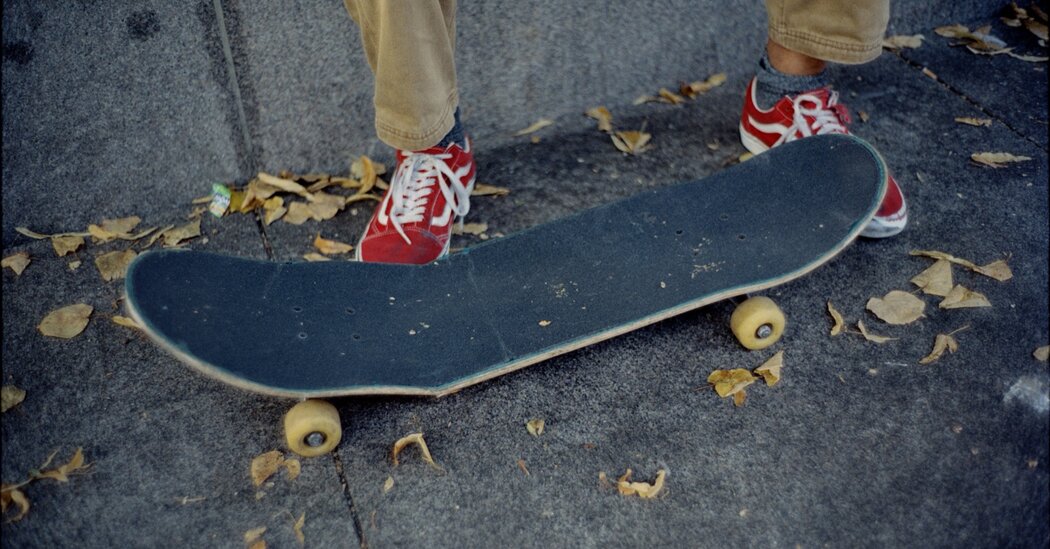
Airlines generally allow you to bring your skateboard as a carry-on item. The people who do this are, I would guess, either children or good at skateboarding. I was once one of these things, and am now neither. Even if my flight did allow it, I worried it would cause havoc in the overhead bins; I couldn’t handle the thought of arguing my case to rollerboard-toting businessmen the same age as me. No — the board would have to be checked. While packing, I discovered it was too long for even my biggest duffel, so I grabbed my golf travel bag from the basement, wrapped the board in plastic and threw my clothes in with it. Shouldering a half-flaccid golf bag through the airport, I looked like a sight gag from an old Playboy cartoon. But at least I didn’t have to bring my skateboard into the Air France lounge.
My destination: Malmo, Sweden, a once-gritty shipbuilding town that has refashioned itself over the last two decades into the type of place this newspaper might recommend you spend 36 hours in. One minor but fascinating element of Malmo’s postindustrial turnaround has been an effort to incorporate skateboarding into the fabric of the city. Even more tolerant urban governments in the United States tend to cordon skaters off in parks, sometimes very nice ones, but in southern Sweden, they’ve been trying something different: treating skateboarding like a unique source of vitality rather than a nuisance to be managed. I flew there at the end of August to see the crowning achievement of Malmo’s efforts — the reconstruction of one of the most iconic spots in skateboarding history, imported, piece by piece, from Philadelphia.
John F. Kennedy Plaza single-handedly made Philly a skateboarding town. It’s better known as Love Park, after the Robert Indiana sculpture that was installed there in 1976, and is much better known among skateboarders than the civilian public. The park was laid out in the 1960s, part of an effort to revitalize Philadelphia as its industrial base declined, a place for the new Organization Man to take lunch al fresco. Within a couple of decades, it would become a magnet for the city’s growing homeless population, thinning out the lunch crowd while creating room for a new species to emerge: the puffily shod, baggily pantsed street skater of the 1990s.
Love’s heyday coincided with the apex of skateboarding’s predigital monoculture, an era when print magazines and VHS tapes still defined its boundaries. In a relatively information-poor environment, Love could enjoy a level of exposure and mystique now unimaginable for a skate spot, or anything else, really. It was featured in magazines and videos constantly. And it was, judging from these, a sort of paradise: granite ledges blackened with wax, more than enough to go around; pavers that could be wrenched out of the ground with skateboards, propped up and made into ramps; an enormous fountain at the bottom lined with more waxed granite. The ground, also made of granite, looked smooth — it sounded smooth, too. Love nurtured a technical sort of skateboarding, one focused on precision and style, on stringing together long lines of tricks, a demonstration of mastery made possible by the plaza’s serendipitously perfect layout.
But what was truly thrilling about Love was that skateboarding happened there at all. It was a plaza in the middle of a Northeastern metropolis, monumental and purpose-built for something else. If you squint at the footage, you can almost make out William Penn himself, standing atop City Hall just across the street, overseeing the action. This unlikely proximity eventually led to problems. After battling the skaters for years, the city demolished and redesigned the plaza in 2016.
Thank you for your patience while we verify access. If you are in Reader mode please exit and log into your Times account, or subscribe for all of The Times.
Thank you for your patience while we verify access.
Already a subscriber? Log in.
Want all of The Times? Subscribe.